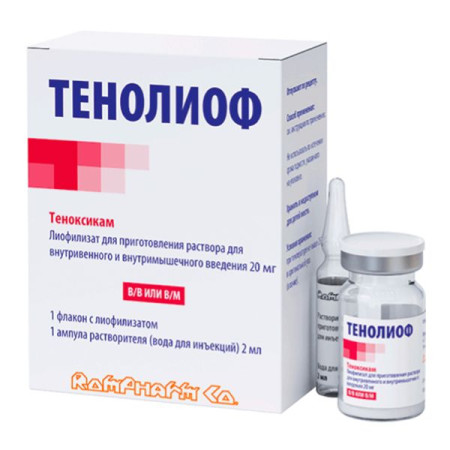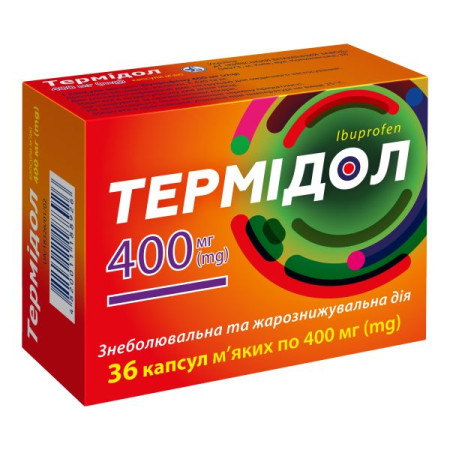Piroxicam Sopharma hard capsules 10 mg blister No. 20

Piroxicam Sopharma capsules are used for the symptomatic treatment of osteoarthritis, rheumatoid arthritis or ankylosing spondylitis. Due to its safety profile, piroxicam is not a first-line treatment when other nonsteroidal anti-inflammatory and antirheumatic drugs are indicated. The decision to prescribe piroxicam should be based on an assessment of the individual overall risk to the patient.
Composition
The active substance is piroxicam (one capsule contains piroxicam 10 mg).
Excipients: wheat starch, microcrystalline cellulose, glycine, colloidal anhydrous silicon dioxide, magnesium stearate, talc; hard gelatin capsule: gelatin, titanium dioxide (E 171), indigo carmine (E 132).
Contraindication
Use is contraindicated in:
hypersensitivity to the active substance or to excipients, transient skin reactions (regardless of their severity) in response to the use of piroxicam, other non-steroidal anti-inflammatory and antirheumatic drugs and other drugs; simultaneous use of other non-steroidal anti-inflammatory drugs (NSAIDs), including selective COX-2 inhibitors and acetylsalicylic acid in analgesic doses; history of gastrointestinal ulcers, active peptic ulcer disease, inflammatory gastrointestinal diseases or gastrointestinal bleeding, perforation, gastrointestinal cancer or diverticulitis; history of gastrointestinal disorders that create a predisposition to bleeding, such as ulcerative colitis, Crohn's disease; simultaneous use of anticoagulants; hemorrhagic diathesis, changes in the blood picture of unclear genesis (including in history); history of serious allergic reactions of any type, especially skin reactions such as erythema multiforme, Stevens-Johnson syndrome, toxic epidermal necrolysis; severe heart failure; severe renal and hepatic failure.Contraindicated in patients in whom recent use of acetylsalicylic acid and other NSAIDs has induced the development of bronchial asthma, rhinitis, nasal polyps, angioedema and/or urticaria.
Method of application
The initial prescription of piroxicam should be carried out by a physician experienced in the diagnosis and treatment of patients with inflammatory or degenerative rheumatic diseases.
The maximum recommended daily dose is 20 mg.
Side effects can be reduced by using the lowest effective dose for the shortest period of time necessary to control symptoms.
The benefit of treatment and tolerability of the medicinal product should be reviewed every 14 days. If prolonged treatment is considered necessary, this reassessment should be carried out more frequently.
Given the proven fact that the use of piroxicam is associated with an increased risk of gastrointestinal complications, the need for combination treatment with gastroprotective drugs (e.g. misoprostol or proton pump inhibitors) should be carefully considered, especially for elderly patients.
Adults should take two 10 mg capsules orally once a day, preferably during or immediately after meals, with water. The duration of treatment depends on the course of the disease and is determined by the doctor. When combined administration of different forms of the drug (capsules, tablets, solutions, suspensions, suppositories), the total daily dose should not exceed 20 mg.
For patients over 65 years of age, special caution is required when treating with piroxicam, especially for patients with impaired renal, hepatic or cardiac function.
Application features
Pregnant women
Piroxicam should not be used during pregnancy due to the lack of sufficient data on its safety. No teratogenic effects were observed in experimental animal studies. Piroxicam reduces the synthesis and release of prostaglandins by reversible blockade of the enzyme cyclooxygenase. This effect, as with other NSAIDs, is associated with an increase in the incidence of complicated and prolonged labor in experimental animals if the drug is continued into late pregnancy. NSAIDs are known to have the potential to induce premature closure of the ductus arteriosus in newborns.
Experimental studies show that the amount of piroxicam that penetrates into breast milk is approximately 1% to 3% of its concentration in maternal plasma. No cumulation in breast milk has been observed.
The use of the drug during breastfeeding is contraindicated due to the lack of sufficient data on its safety or requires the cessation of breastfeeding for the period of treatment.
Children
There is insufficient clinical experience regarding the safe use of piroxicam in children.
Drivers
Piroxicam may cause side effects such as tinnitus, dizziness, drowsiness, auditory and visual disturbances, which may impair active attention and reflexes. Drivers of vehicles and machine operators should take these adverse effects into account, especially at the beginning of treatment with piroxicam.
Overdose
Treatment: symptomatic, it is necessary to take into account the long half-life of piroxicam, it should be assumed that the elimination of piroxicam can be accelerated by the administration of antacids and activated charcoal.
Primary elimination of the drug (careful gastric lavage), monitoring of acid-base balance, correction of electrolyte levels, correction of glucose levels, intensive medical care, acceleration of the elimination process (alkalized, forced diuresis), administration of diazepam in case of seizures.
The use of activated charcoal (only in conscious patients) affects the resorption and absorption of piroxicam and, thus, reduces the total amount of the active substance of the drug in the blood serum.
Piroxicam cannot be removed from the body by hemodialysis.
Side effects
On the part of the gastrointestinal tract: ulcerative stomatitis, esophagitis, gastritis, glossitis, hematemesis, rectal bleeding, melena, anorexia, epigastric pain, constipation, diarrhea, dyspepsia, flatulence, belching, heartburn, nausea, vomiting, severe hemorrhages / perforations and ulcers (stomach, duodenum) - there is a risk of asymptomatic perforation, exacerbation of colitis or Crohn's disease, pancreatitis, pain / discomfort in the stomach, indigestion.
Nervous system: dizziness, headache, vertigo, feeling of disorientation, anxiety, weakness, impaired concentration, depression, drowsiness, insomnia, hallucinations, increased fatigue, irritability, psychotic reactions, mood changes, sensory disturbances including paresthesia, memory impairment, confusion, nervousness, abnormal dreams, convulsions.
Cardiovascular system: palpitations, angina pectoris, tachycardia, heart failure, edema, hypertension, arrhythmia, increased risk of thrombotic complications (myocardial infarction or stroke).
From the side of the blood and lymphatic system: eosinophilia, leukopenia, nonthrombocytopenic Henoch-Schonlein purpura, epistaxis, agranulocytosis, thrombocytopenia, hemolytic anemia, aplastic anemia, the appearance of antinuclear antibodies.
Skin and subcutaneous tissue disorders: pruritus with or without rash, rash, photosensitivity, severe skin reactions (SCARs): Stevens-Johnson syndrome and toxic epidermal necrolysis (Lyell's syndrome), exfoliative dermatitis, bullous rash, redness, eczema, purpura of allergic type.
Renal and urinary disorders: edema, fluid retention, polyuria, hematuria, dysuria, interstitial nephritis, nephrotic syndrome, proteinuria, acute renal failure, papillary necrosis, reversible increase in plasma urea and creatinine levels.
From the organs of vision: diplopia, blurred vision, eye irritation, eye swelling.
From the side of the organs of hearing and labyrinth: hearing impairment, tinnitus.
Hepatobiliary disorders: increased serum transaminase levels (ALAT, ASAT), transient increase in bilirubin levels, toxic hepatitis, including with jaundice, fulminant hepatitis, hepatic failure.
Immune system disorders: hypersensitivity reactions, including bronchospasm, anaphylactic or anaphylactoid reactions in patients with allergies, serum sickness, urticaria/angioedema, vasculitis, erythema multiforme.
Respiratory system: respiratory depression, pneumonia.
Metabolism and nutrition disorders: hypoglycemia, hyperglycemia, weight gain or loss.
General disorders: taste disturbance, fever, flu-like symptoms, general malaise, increased sweating, onycholysis, nail growth disorder, alopecia.
Storage conditions
Store in the original packaging at a temperature not exceeding 25 °C, out of the reach of children.
Shelf life - 3 years.
There are no reviews for this product.
There are no reviews for this product, be the first to leave your review.
No questions about this product, be the first and ask your question.








